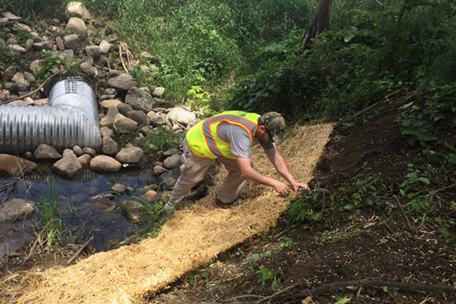
Rain gardens. Green roofs. Bioswales. Constructed wetlands. As older graywater systems age, more and more are being replaced with these and other types of green infrastructure (GI). GI essentially treats water on site by using it in the landscape, and/or allowing it to percolate naturally into the earth. This diverts water from the storm sewer system, helping to prevent overflow and protect the water supply. It provides many other environmental and social benefits as well.
GI can be as cost-effective as it is sustainable. But, you can’t treat it the same way you do gray infrastructure – especially when it comes to maintenance. It requires a completely different approach.
Shifting to a Green Infrastructure Mindset
Because GI is a new concept to many people, it’s not uncommon for traditional landscape and construction companies to approach GI infrastructure in a very traditional way. This can lead to costly mistakes. For example, permeable pavement is supposed to be porous in order to let rainwater soak into the ground. But after one contractor installed it in a parking lot, they followed conventional practice and applied a sealant, which permanently destroyed the GI value of this project.
For a GI system to function properly, many elements must work together in synergy. Proper GI design and maintenance requires a comprehensive understanding of how all its elements—including built infrastructure, plants, water, and soil—work together to create the desired results. Green infrastructure maintenance also takes a diversified skill set.
What Does Green Infrastructure Maintenance Involve?
The amount of GI maintenance needed varies from project to project, and also by age of project. Typically, maintenance needs will be heavy at first as a system gets set up. The need for maintenance usually reduces as it matures. Most GI installations will require at least monthly or annual maintenance, and most will also need maintenance after heavy rain events.
The most common green infrastructure maintenance tasks include:
- Monitoring drainage. GI maintenance crew members should be alert to drainage red flags such as standing water in a pond that’s supposed to drain in less than 72 hours and be prepared to address these issues.
- Weeding. Invasive species can be a real problem if allowed to proliferate. A lot of the maintenance that needs to be done on GI structures involves plant ID and weeding the beds to ensure a healthy mix of plants.
- Trimming and pruning. Like conventional landscapes, GI installations need regular care to maintain aesthetic and safety standards.
- Trash removal. Most GI projects are in urban areas and tend to build up lots of trash and debris which must be removed on a regular basis.
The installer of each GI structure, from the green roof to rain harvesting device to the rain garden, should include an O&M manual that explains how it should be cared for. Property managers should make it a priority to schedule maintenance accordingly.
Maintenance Matters
Properly maintained green infrastructure provides many environmental, social, and cost benefits. It diverts stormwater, preventing sewage overflow. It reduces runoff, protecting water quality in lakes and streams. It provides habitat for pollinators and other wildlife, beautifies urban environments, reduces heat island effect, and has even been shown to reduce criminal activity in urban areas.
But, these projects do require proper care and maintenance if they are to work cost-effectively. Ensuring that maintenance crews are properly trained to understand the methodologies and are equipped with the right tools for the job goes a long way to ensuring that GI installations deliver their intended value.



